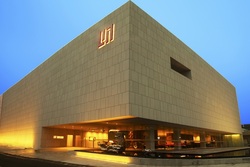
Last week was the third edition of Art Stage Singapore, which is quickly nipping at the heels of Art Basel in Hong Kong and trying to grab a share of the Asian art market. I unfortunately could not attend but preliminary reports were positive. According to the Wall Street Journal, sales were up and galleries in general were happy with the turn out. Shanghai's own ShanghArt Gallery sold a piece from Ding Yi for $450,000!
Shanghai was relatively quiet as a result, save for a few new openings on the Bund at the Rockbund Art Museum (more on that later this week), Studio Rouge, and Pearl Lam Galleries. I did have an opportunity to speak to Wang Wei, founder and director of the new Long Museum in Pudong, in preparation for a piece I'm writing for Art Asia Pacific. An earlier visit to the museum with Rebecca Catching of OV Gallery left a positive impression on me so I was eager to find out more about the woman behind the ambitious space.
I'll quickly give a run down of what to expect if you visit the museum. There was much talk of her Chinese contemporary art collection so I was waiting to be impressed. But aside from a few early pieces from Geng Jianyi, Zhang Peili, and Zhou Chunya, there was no rhyme or reason to the collection. It was basically a who's who of the Chinese art market. All the major artists from the past twenty years were there but there were no major pieces. One can definitely tell that she "shops" for art rather than "collects".
Once we got to the second floor, I was ready to change my mind about her. "Revolutionary Art Since the Yan'An Era: 1942 - 2009" is mind blowing in its breadth. There are staggering number of original propaganda oil and ink paintings, watercolors, and wood block prints. It's a remarkable collection especially in comparison the measly showing of historical propaganda art at the China Art Museum, which covers two small galleries.
The third floor comprised of traditional art, mostly ink paintings, that go back to the Song Dynasty (if I remember correctly). This collection is nothing compared to what you can find at the Shanghai Museum but they definitely spent proper money on installing the show. It's rare to see such professionalism in a museum in China. The highlights from this collection came towards the end, with a small gallery dedicated to several pieces by Qi Baishi (which I actually liked, although I'm not generally a fan). I can't imagine what those pieces are worth now!
I'm going over my notes now for my AAP piece and still haven't figured out how to present the museum and the woman behind it. The task is made even more difficult when you factor in her second museum, which she plans to open later this year on this side of the river. Two museums in less than two years. This is going to be a tricky profile to write.
Shanghai was relatively quiet as a result, save for a few new openings on the Bund at the Rockbund Art Museum (more on that later this week), Studio Rouge, and Pearl Lam Galleries. I did have an opportunity to speak to Wang Wei, founder and director of the new Long Museum in Pudong, in preparation for a piece I'm writing for Art Asia Pacific. An earlier visit to the museum with Rebecca Catching of OV Gallery left a positive impression on me so I was eager to find out more about the woman behind the ambitious space.
I'll quickly give a run down of what to expect if you visit the museum. There was much talk of her Chinese contemporary art collection so I was waiting to be impressed. But aside from a few early pieces from Geng Jianyi, Zhang Peili, and Zhou Chunya, there was no rhyme or reason to the collection. It was basically a who's who of the Chinese art market. All the major artists from the past twenty years were there but there were no major pieces. One can definitely tell that she "shops" for art rather than "collects".
Once we got to the second floor, I was ready to change my mind about her. "Revolutionary Art Since the Yan'An Era: 1942 - 2009" is mind blowing in its breadth. There are staggering number of original propaganda oil and ink paintings, watercolors, and wood block prints. It's a remarkable collection especially in comparison the measly showing of historical propaganda art at the China Art Museum, which covers two small galleries.
The third floor comprised of traditional art, mostly ink paintings, that go back to the Song Dynasty (if I remember correctly). This collection is nothing compared to what you can find at the Shanghai Museum but they definitely spent proper money on installing the show. It's rare to see such professionalism in a museum in China. The highlights from this collection came towards the end, with a small gallery dedicated to several pieces by Qi Baishi (which I actually liked, although I'm not generally a fan). I can't imagine what those pieces are worth now!
I'm going over my notes now for my AAP piece and still haven't figured out how to present the museum and the woman behind it. The task is made even more difficult when you factor in her second museum, which she plans to open later this year on this side of the river. Two museums in less than two years. This is going to be a tricky profile to write.
Above image taken from Jing Daily.
 RSS Feed
RSS Feed